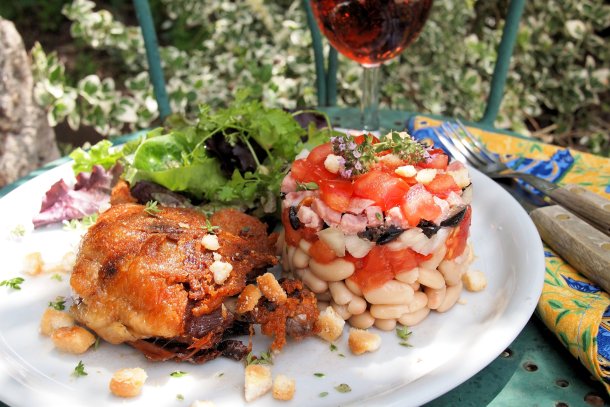
Cassoulet salade d’été avec confit d’canard (Bean & Duck Summer Salad)
Sud de France Festival
Cassoulet salade d’été avec confit de canard
(Summer Cassoulet Salad with Preserved Duck)
The Sud de France Festival is on in London right now – it runs from the 11th to the 29th June 2012; the festival celebrates the Mediterranean flavours of Languedoc-Roussillon, one of my favourite parts of France as it happens, and I was recently asked to create a recipe to celebrate this wonderful area of gastronomy, as part of the Sud de France Bloggers Recipe Competition – which is a chore I know, but someone has to do it! I was asked to design a recipe inspired by the flavours and ingredients of the Sud de France region, to promote and highlight some of the special recipes and ingredients that originate from that part of South France. The area is rich with many famous products and recipes, including Cassoulet, which is made from dry white beans and meat (pork, duck and/or goose). Cassoulet was originally made with broad beans, instead of haricot beans that are used to make it nowadays. Legend says that this dish was invented during siege of the city of Castelnaudary; the starving villagers of the beleaguered city would have gathered all the available food to cook a gigantic stew to invigorate the soldiers who were protecting them and their towm. Cassoulet is one of my very favourite dishes, but I usually only cook and eat it during the colder months, as it is traditional comfort food. However, it contains some fabulous ingredients, and so I decided to “deconstruct” the recipe and then “reconstruct” it into a fabulous summer dish…….so I am proud to present my recipe, which I’ve called Cassoulet salade d’été avec confit de canard (Summer Cassoulet Salad with Preserved Duck).
It’s quite a “cheffy” recipe, well, insofar that I have assembled the bean salad in a cooking ring, which looks great on the plate actually…….and, ever better news, my “salad stack” did not collapse either! I took all the principal elements of a classic Cassoulet and reinvented the dish for summer. A classic Cassoulet contains haricot blancs (white haricot beans), tomatoes, onions, preserved duck, garlic sausage, wine, thyme and bread crumbs….obviously there are variations on this recipe, and different parts of South West France all have their own regional recipe with the “correct authentic” recipe being hotly debated. I was delighted with this recipe, the flavours worked so well together and the contrast of textures was also very clever, and worked perfectly, as did the hot duck with the cold bean salad and mesclun salad leaves. The flavours were definitely VERY Sud de France, and we both enjoyed this last Sunday, as an alternative Sunday Lunch, with a glass of rose wine on the terrace, whilst the sun was out……. briefly! My ingredients list contained nearly all of the key elements needed for the hot and comforting version of this dish, with a few black olives thrown in for good measure.
The ingredients and recipes that make up the Sud de France are, and this is by no means a definitive list, are as follows:
Tomatoes
Tapenade: The name comes from the Occitan “tapeno” which means capers. Its basic ingredients are capers mixed with mashed green or black olives from the Languedoc-Roussillon region, anchovies can also be added to it. French people in the South of France enjoy tapenade as an appetizer, spread over hot toast. It also goes perfectly with raw vegetables, as a starter.
AOC Sweet Onion from the Cevennes
Rousquilles: The name of those small Catalan biscuits comes from their shape (rosca, “ring-shape” in Catalan). There are simply irresistible with their shortbread soft and melting texture. Covered by a thin glaze of anise-flavoured or vanilla-flavoured icing sugar.
Picholine olives
Petits Pâtés de Pézenas: These pies are stuffed with roast mutton and candied lemon zest. Originally from India, these little sweet and sour pies were introduced in the area duting the 18th century, when Lord Clive (governor of the East Indies) travelled to the pretty town of Pézenas.
AOC Pelardon Cheese: This sharp and peppered small AOC cheese is made from goats’ milk. It is recognized by its strong character and its light nutty flavour. The Pelardon can be found fresh, half dry or dry, and is perfect at the end of a meal or in a salad. It can be served hot as well as cold. The drier it is, the stronger it tastes.
Peaches and Nectarines from the Roussillon and the Costières areas
Olive Oil
Lucques olives
Honey
Collioure Anchovies: The Collioure anchovy is a culinary speciality of the small town of the same name in the Pyrénées-Orientales. It can be found in many different forms: packed in salt, in oil, mashed into an anchovy cream, in a tapenade (olive spread) or an “anchoïade” (dressing made from tapenade, anchovies cream and olive oil), stuffed into olives, fried or in soup. Catalan cuisine also uses it in salads and as an appetizer on a grilled slice of bread, with crushed tomatoes.
Cod Brandade of Nîmes: “Brandade de Morue” is born from the exchange between cod fished by the Breton’s Terre-Neuvas and the sea salt of the salt workers from the Camargue region. Cod brandade first entered into “nîmoise” gastronomy during the 18th century when cooks transformed the cod into a mash, with milk, olive oil and wild local herbs. It can be served, au gratin or spread on toast.
Charcuterie from Lozère
Catalan Charcuterie
Cassoulet
Camargue Sea Salt
AOC Camargue Rice
AOC Camargue Beef/Bull: Originally, those small black bulls were reared for Camargue racing. But, their surprising musky meat became very popular. The AOC Camargue Bull is eaten throughout the whole region, grilled as well as stewed in a stew called a “gardianne” with a red wine sauce.
Bouzigues Oysters
AOC Bleu des Causses Cheese
Apricots (from Roussillon and the Costières)
I used traditional Cassoulet components of haricot beans, tomatoes, onions, garlic sausage, olive oil, thyme, preserved duck and bread crumbs. I also added some French olives, red wine vinegar with shallots, mesclun salad leaves and the ubiquitous glass of rose wine…….of course! I think my recipe epitomises the region perfectly and I was certainly inspired by the flavours and ingredients from the Sud de France region, and I loved developing this recipe for the competition. If you cannot source confit de canard, preserved duck, you can use magret de canard, duck breasts, instead……just fry them in some duck fat, in the same way as the duck legs, but maybe reduce the cooking time for a pink (medium) finish. For a fancy flurry of a finish, try to source thyme flowers too….they are often used in South West French cooking, in tians and salads and finish the dish of beautifully.
I hope you may try this recipe this summer, it makes a fabulous and extremely tasty luncheon dish, as well as an elegant al fresco supper, sat on the terrace maybe, with candles and the scent of garden flowers…..if summer finally arrives that is! That’s it for today, this is my alternative offering for Sunday Lunch, Sud de France style! See you tomorrow, Karen.
Cassoulet salade d’été avec confit de canard (Summer Cassoulet Salad with Preserved Duck)
| Serves | 2 |
| Prep time | 10 minutes |
| Cook time | 20 minutes |
| Total time | 30 minutes |
| Meal type | Lunch, Main Dish, Salad |
| Misc | Gourmet, Pre-preparable, Serve Cold, Serve Hot |
| Occasion | Barbecue, Birthday Party, Casual Party, Formal Party, Valentines day |
| Region | French |
| By author | Karen S Burns-Booth |
Ingredients
Cassoulet salad
- 4 tablespoons tinned white (haricot) beans
- 1 large tomato (very finely diced into small dice)
- 1/2 white onion (peeled, and very finely diced into small dice)
- 2 tablespoons French black olives (chopped into fine dice)
- 50g French garlic sausage (very finely diced into small dice)
- fresh thyme sprigs (with flowers)
Confit de Canard
- 2 cuisse de confit de canard (2 whole preserved duck legs in duck fat)
Salad
- Mesclun leaves with herbs (about 100g)
- 4 tablespoons French extra virgin olive oil
- 2 tablespoons French red wine vinegar with shallots
Garnish
- 1 slice of toasted baguette (broken or crushed into breadcrumbs)
Note
Deconstructed cassoulet in a summer salad with crispy duck legs and mesclun salad.....all the elements of a winter warmer but lightened up for an elegant and very French lunch!
Directions
| Step 1 | First assemble your cassoulet salad on the plate that you are serving your meal on - I like to use a large white plate. Take a 3"/8 cms diameter cooking ring/mould, that is at least 2"/6cms high and place it to one side on the plate. Start with the white beans, put 2 tablespoons into each ring, and press down firmly without crushing them. Add the finely diced tomatoes next (leaving some for the top) and press down firmly with the back of a spoon. Next, add the onions, olives, garlic sausage and then end with some more tomatoes, pressing down firmly between each addition of ingredients. Allow the salad to sit in the rings until the duck has been cooked and the meal is ready to serve. Cover and put to one side in a cool place. |
| Step 2 | Next cook your preserved duck legs; I like to cook mine outside on the BBQ whenever possible, and cook them in a large work. Heat up some of the excess duck fat (that the duck legs came in), in a large roomy frying pan or wok, and then add the duck legs FLESH side down first. Cook over a medium heat for 8 to 10 minutes, and then turn up the heat to high and turn the legs over so the skin side is down now. Cook over a high heat for about 8 to 10 minutes, or until the skin is golden brown and very crisp. Drain well and place the duck legs on the same plate that the cassoulet salad has been assembled. |
| Step 3 | Put some mesclun leaves to one side on the plates, and then VERY carefully pull the rings up and off the cassoulet salad, leaving a compact shaped salad, see photos. Mix the olive oil and vinegar together and then drizzle the vinaigrette over both salads and around the plate. Garnish with the toasted bread crumbs and scatter more thyme leaves and thyme flowers over the dish. Serve with South Western Rose wine and fresh baguette. |

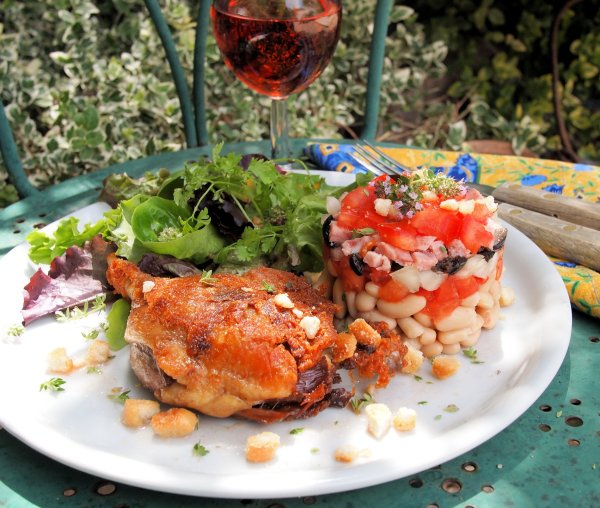
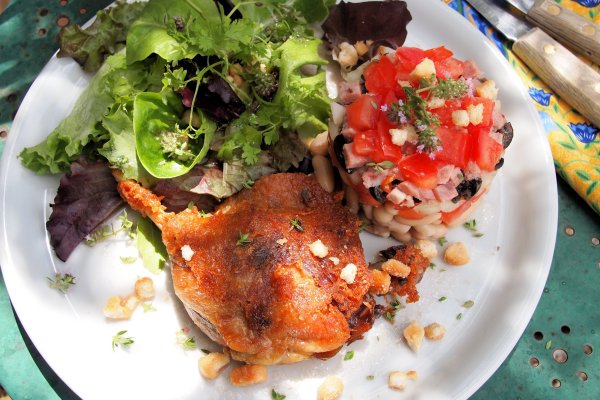
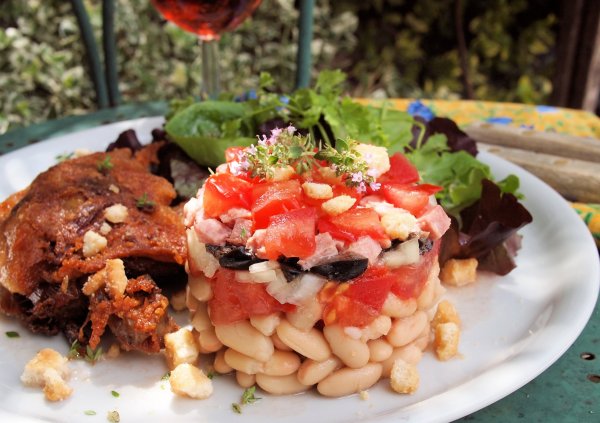
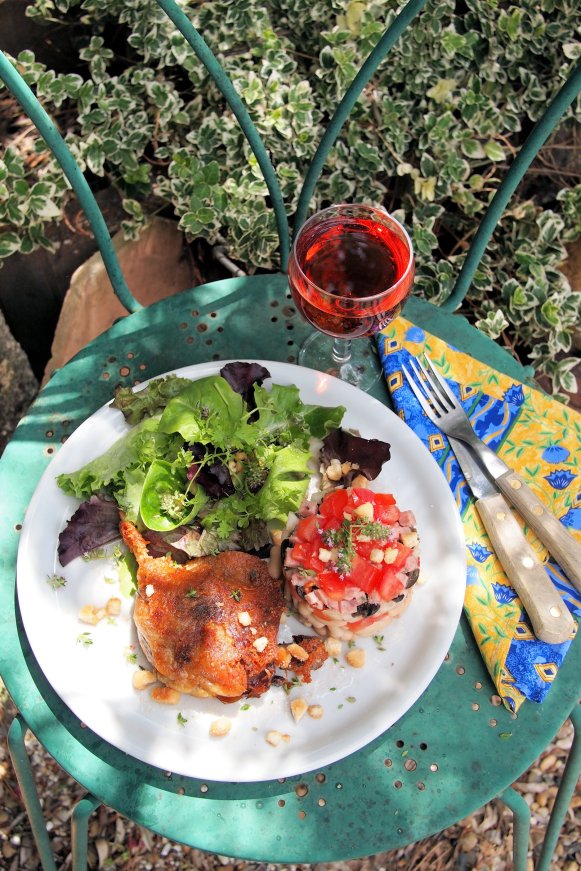
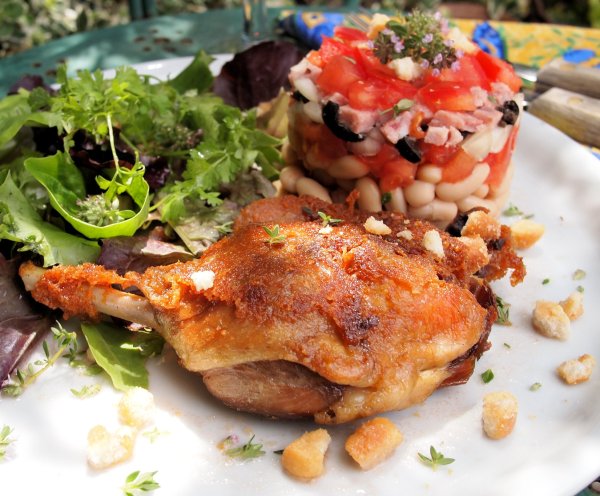
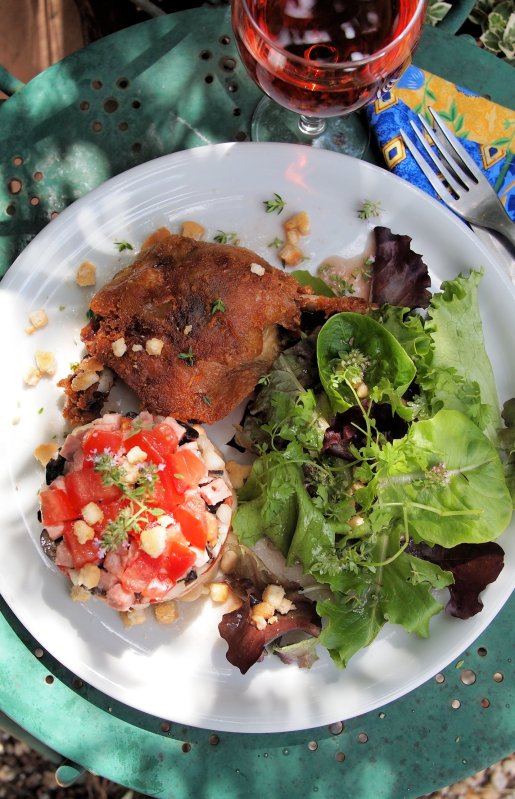
 Print recipe
Print recipe
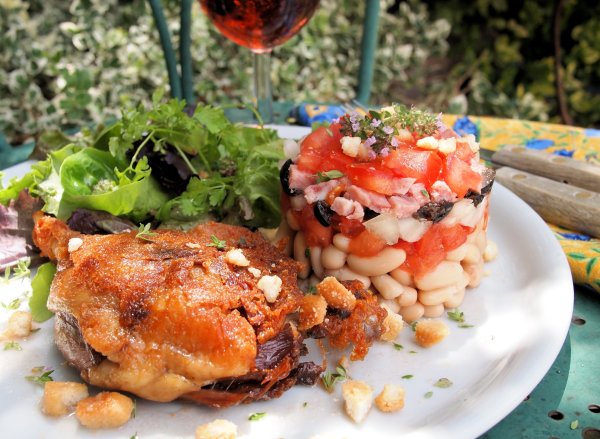
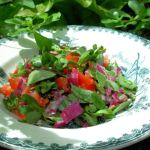



Jude A Trifle Rushed says
Karen, one of my favourite combinations, duck with beans, and I just love your presentation, it looks so very elegant. I’m sure I’ll be checking this page in a few weeks time to make a delicious supper once I’m in France.
Karen says
Thanks Jude – I thought of you when I was developing this recipe, and this really is a GREAT way to enjoy all the components of cassoulet in the summer! Let me know when you are en France! 🙂 Karen
Fiona Maclean says
I love confit de canard. I try to avoid loving it because I suspect it is just a little calorific…and I REALLY don’t need a recipe that I can make in summer using it!:)
Karen says
IT is a LITTLE calorific Fiona, BUT, duck fat is VERY good for you and is a good fat, so not so naughty maybe!
Phil in the Kitchen says
Lovely variation on the classic flavours and most suitable for the summer. I just adore confit de canard at any season. Actually, I love so much of the food of Languedoc-Roussillon now that you come to mention it. I was recently reminded that it was while eating Collioure anchovies that I decided to start a blog.
Karen says
Thanks Phil; what a wonderful reason for starting of your blog – culinary pleasure of extreme proportions……I can also eat confit de canard at any time of the year, or week or day……:-)
kellie@foodtoglow says
Lovely deconstructed recipe with lots of historical context, as per usual. I also really like your listing of the south of France culinary highlights. I feel quite chuffed that I know and have tasted most everything on the list. Didn’t realise I was so worldly!
Karen says
Thanks Kellie – you are VERY worldly, I love your posts and recipes, they are always so well written and unique….I know I have not been by for a week or so, but I am on my rounds tomorrow and am excited, as well as intrigued, to see what you have been up to lately! Like you, I have had the privilege of tasting everything on the list, and whilst being in the area too….Karen 🙂
Louisa says
I am loving the idea of a summery deconstructed cassoulet! One of my favourite winter dinners but just too heavy for this time of year. Cannot wait to try this!
Karen says
DO let me know if you try this, I was REALLY pleased with how it turned out!
Laura@howtocookgoodfood says
Such a lovely idea and I will be making this when in France for sure. In fact, I might just have to print off loads of your recipes along with Jude’s and then all I have to do is try them all out. May do a blog post about them all, if you don’t mind!
Karen says
Thanks Laura! I was so chuffed to hear that I won too….I won dinner for two at Koffman’s in London to the value of £250! I would be delighted if you blogged about it, what a lovely idea for a post, I may “borrow” that idea and do one too, and what a great idea to print the recipes off before you go! Karen